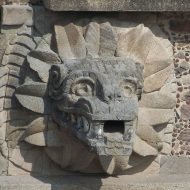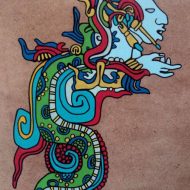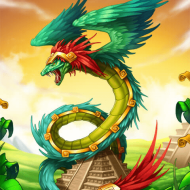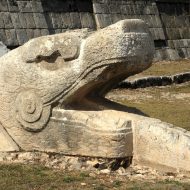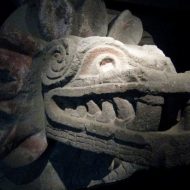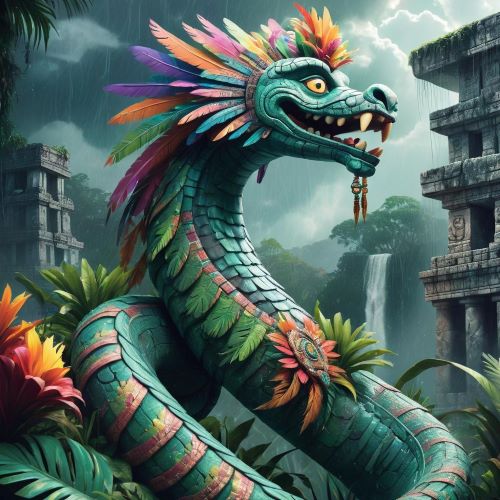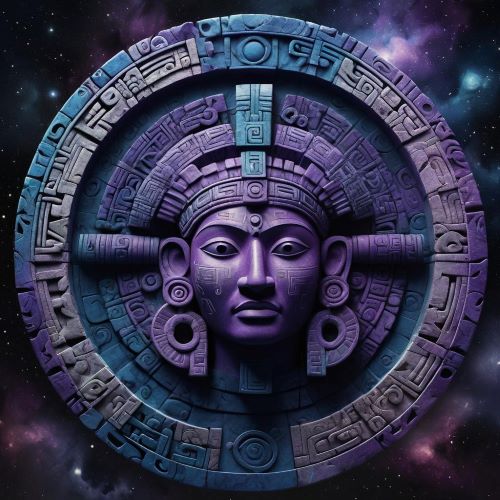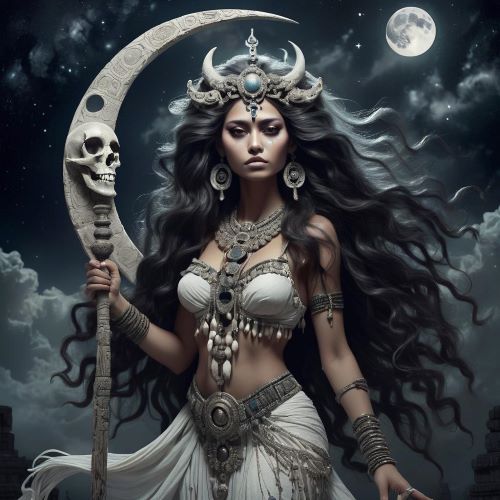Kukulkan : The Serpent God
Listen
At a glance
| Description | |
|---|---|
| Origin | Mayan Mythology |
| Classification | Gods |
| Family Members | N/A |
| Region | Mesoamerica, South America |
| Associated With | Rain, Wind |
Kukulkan
Introduction
In the heart of Mesoamerican mythology, Kukulkan—the feathered or plumed serpent—is one of the most iconic deities of the Yucatec Maya. Revered as a powerful creator, Kukulkan was associated with the wind, rain, fertility, and cosmic order. He is often depicted as a serpent adorned with feathers, merging the symbolism of earth and sky into a single divine form. The cult of Kukulkan reached its peak at Chichen Itza, where the massive pyramid of El Castillo was constructed in his honor, designed to interact with the sun’s movements during equinoxes and illuminate the plumed serpent in a spectacular display.
Kukulkan’s mythology transcends mere folklore; he represents the interconnectedness of life, death, and the natural cycles. The serpent in Mesoamerican belief symbolized life both above and below the earth, linking the living world to the underworld. The snake’s habit of dwelling in caves allowed it access to the underworld, while its movement across the land connected humans to the skies above. Kukulkan, therefore, embodied the union of earth, sky, and spiritual realms, acting as a bridge between humanity and the gods.
Historically, Kukulkan’s identity sometimes merged with historical figures. In the 10th century, a ruler or priest named Kukulkan is said to have led Chichen Itza. However, in earlier depictions, Kukulkan is clearly portrayed as a divine feathered serpent rather than a human leader. Artifacts and carvings from the period depict him coiled around nobles or perched atop temples, demonstrating his celestial and terrestrial significance.
Physical Traits
Kukulkan’s physical form perfectly mirrors his symbolic power. He is most commonly depicted as a serpent with feathers and wings, capable of flight and communication with celestial bodies. In some illustrations, he is a standard snake; in others, he appears as a winged serpent with bird-like features, merging reptilian strength with avian grace. This duality symbolizes his dominion over both the earth and the sky, emphasizing his role as a mediator between worlds.
Artists often rendered Kukulkan in intricate detail, highlighting his scales, feathered crest, and elongated, sinuous body. The serpent’s wings allow him to ascend into the heavens, while his serpentine form keeps him firmly connected to the earth and underworld. In Mayan art, Kukulkan is also depicted interacting with humans, emphasizing his active role in human affairs as a guide, protector, and occasionally, a fearsome deity.
Family
Kukulkan’s origins are as mythical as they are symbolic. Some legends suggest that he was born to humans but quickly grew so enormous that his sister could no longer feed him, forcing him to leave the cave where he was nurtured. This departure caused the earth to tremble, and even today, local traditions say that the tremors in July are reminders of his presence and life force.
Although less is known about a formal “family” of gods for Kukulkan compared to other pantheons, he is conceptually connected to other Mesoamerican deities such as Quetzalcoatl, the Aztec feathered serpent, and Gucumatz, the Guatemalan Maya serpent deity. These variations show that while Kukulkan is uniquely Yucatec Maya, his essence resonates across Mesoamerican cultures as a figure of creation, wisdom, and power.
Other Names
Kukulkan is known by different names depending on the culture and region. Among the Aztecs and Toltecs, he is referred to as Quetzalcoatl, literally meaning “feathered serpent” in Nahuatl. The Guatemalan Maya call him Gucumatz, while the Gulf Coast tribes sometimes referred to him as Ehecatl, emphasizing his association with the wind. These multiple identities reflect Kukulkan’s widespread influence and the shared symbolism of the feathered serpent throughout Mesoamerica.
Powers and Abilities
Kukulkan’s powers are vast and multifaceted, blending natural, spiritual, and cosmic elements. He is regarded as a creator deity, bringing rain, fertility, and wind to sustain life. The wind, in particular, was seen as a divine element under his control, with a mythical gemstone believed to be the source of all air resting in his possession.
Architectural structures, especially the pyramids at Chichen Itza, were designed to honor and appease Kukulkan. During equinoxes, sunlight casts shadows that resemble a serpent slithering down the staircase of El Castillo, symbolizing his descent to earth. Rituals, including offerings and human sacrifices in some instances, were performed to gain his favor, reflecting the intertwined nature of reverence and fear in Mayan religious practice.
Kukulkan is also credited with imparting knowledge to humanity, including the Mayan calendar, a monumental stone disk representing celestial cycles and timekeeping. His association with elements, celestial phenomena, and wisdom made him a central figure in Mayan cosmology. Beyond natural control, Kukulkan held symbolic authority over life, death, and the passage of time, bridging human understanding with divine order.
Modern Day Influence
Kukulkan remains a vibrant figure in both academic research and popular culture. Archaeological studies at Chichen Itza and other Mayan sites continue to reveal new insights into his worship, architecture, and ritual practices. His image as a feathered serpent is one of the most recognized symbols of Mesoamerican heritage, appearing on artwork, national emblems, and cultural events in Mexico and Central America.
Beyond scholarly interest, Kukulkan has found a place in modern entertainment. He has appeared in television, including animated series like Star Trek: The Animated Series, as well as in video games such as Smite and Tomb Raider. These representations often highlight his mythological significance, emphasizing his power, wisdom, and connection to both sky and earth.
Kukulkan’s enduring legacy is not merely a reflection of ancient worship but a testament to the continued fascination with Mesoamerican culture. From ceremonial pyramids to contemporary media, the plumed serpent’s influence continues to inspire awe and curiosity, bridging millennia of human imagination.
Related Images
Sources
Wikipedia contributors. (2025, September 11). Kukulkan. Wikipedia. https://en.wikipedia.org/wiki/Kukulkan
World History Encyclopedia. (2021, January 25). Kukulcan: The Feathered-Serpent God of Mesoamerica. https://www.worldhistory.org/Kukulcan/
HowStuffWorks. (2024, February 23). Kukulkan: The Feathered Serpent of Maya Mythology. https://people.howstuffworks.com/kukulkan.htm
Chichen Itza. (2024, September 11). The Feathered Serpent of Chichen Itzá: A Symbol of Mayan and Aztec Power. https://www.chichenitza.com/blog/the-feathered-serpent-of-chichen-itza-a-symbol-of-mayan-and-aztec-power
Ancient Origins. (2018, July 11). Kukulcan, the Snake God of the Maya, Remains as a Symbol of Power. https://www.ancient-origins.net/myths-legends-americas/kukulcan-maya-0010355
Freidel, D., Schele, L., & Parker, J. (1993). Maya Cosmos: Three Thousand Years on the Shaman’s Path. William Morrow & Co.
Coe, M. D., & Koontz, R. (2002). Mexico: From the Olmecs to the Aztecs. Thames & Hudson.
Sharer, R. J., & Traxler, L. P. (2006). The Ancient Maya (6th ed.). Stanford University Press.
Miller, M., & Taube, K. (1993). The Gods and Symbols of Ancient Mexico and the Maya: An Illustrated Dictionary of Mesoamerican Religion. Thames & Hudson.
Frequently Asked Questions
What is Kukulkan God of?
The Mayan God known as Kukulkan was the god of rain, wind, storms, life and knowledge.
Why was Kukulkan worshipped?
Kukulkan was a deity worshipped by ancient civilizations for his role as the god of agriculture and language. According to myth, he gifted humanity with maize and is credited with the invention of human speech and written symbols. In addition, Kukulkan was also associated with earthquakes.
Is Kukulkan Mayan or Aztec?
Kukulkan was the primary deity of the Yucatan people in Mesoamerica. The Aztec god who is very similar to Kukulkan is known as Quetzalcoatl.
What was Kukulkan's greatest gift to humans?
Kukulkan brought a calendar, which is a massive stone disk that dates to a distant future, and presented it to all the humans. This is known as the Mayan calendar.
In what video games is Kukulkan a character?
Kukulkan is a playable character in the video games Smite and Tomb Raider.





